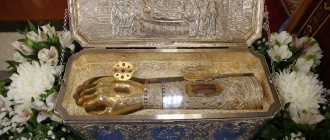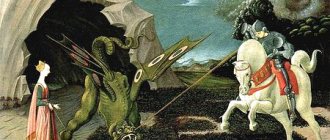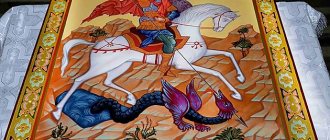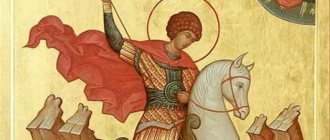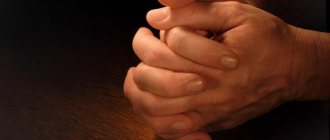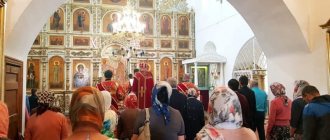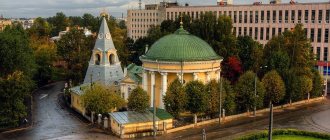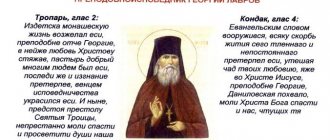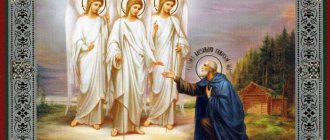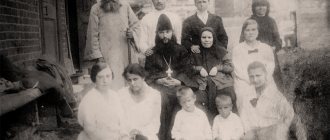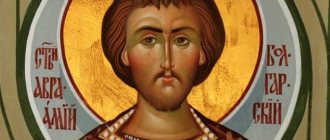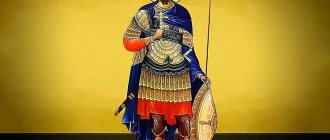"Save me, God!".
Thank you for visiting our website, before you start studying the information, please subscribe to our Orthodox community on Instagram, Lord, Save and Preserve † - https://www.instagram.com/spasi.gospodi/. The community has more than 60,000 subscribers. There are many of us like-minded people and we are growing quickly, we post prayers, sayings of saints, prayer requests, and timely post useful information about holidays and Orthodox events... Subscribe. Guardian Angel to you!
The image of the Great Martyr is considered one of the most revered shrines in the Orthodox Shrine, and it also personifies the intercessor for believers whose life has anything to do with military affairs, but he can also protect landowners. The divine face can be found on some city flags and even on coins.
The shrine of the Great Martyr can be addressed in a prayer service to all Orthodox Christians who have connected their lives with the defense of their homeland. They are called to the Saint to petition for intercession in military conflicts, and parents whose sons have been called to service also pray before the face, so that the image will protect them from all difficulties, and the service will go well.
In this article you can find out how the shrine helps and what the significance of the shrine is, what they pray for to the icon of St. George the Victorious, the day of celebration, prayers to the image and more.
- Prayer for help in work
How does the icon of St. George the Victorious help and its meaning?
This Saint is known to many Orthodox people, but not very religious people have also heard about him. However, not everyone knows what they can ask from the divine face, but this image is capable of healing anyone who sincerely asks.
The meaning of the icon of St. George the Victorious
The shrine, where a warrior kills a snake on horseback, personifies the extraordinary nobility and greatness of the displayed military courage. He is even depicted on some coats of arms and coins, and in Georgia this face is one of the first to be honored after the Queen of Heaven.
The Great Martyr George the Victorious is considered a saint thanks to his sufferings, which he endured because of his Orthodox faith, so strong that he could not exchange it for wealth or power. Faith is what is truly powerful and the most important thing that can be in a person’s life.
The best article for you, go to: St. Philip, Metropolitan of Moscow: life, icon, temple
All of the above exactly corresponds to the image of the Saint. According to stories that have survived to this day, while still in prison, he could help everyone who turned to him with a request. He cried out to God in prayer and he listened to him and fulfilled his requests, granting healing and help to those in need.
One of the greatest miracles that the Great Martyr performed was the salvation of the entire city from the terrifying serpent. Through prayers and his unyielding faith in the Almighty, he was able to defeat the monster. The saint killed the serpent, saved the inhabitants and their souls from the influence of the devil, giving them hope and faith in the Lord, calling people to accept the Christian faith.
Description of the holy image
To fully understand the meaning of the iconographic composition, one should turn to the life of the passion-bearer. George the Victorious was born at the end of the 3rd century and was a native of the Palestinian city of Lydda (present-day Lod, Israel). His father professed the teachings of Christ, for which he was brutally executed, and his pregnant mother fled to Palestine. There she gave birth to a son, whom she later gave a good education.
Icon of St. George the Victorious
The boy grew up strong and strong, and also had a sharp mind. All these qualities served him as a pass to the imperial army, where the future saint served in military service for several years. When persecution of Christians began under the leadership of Diocletian, George tried to convince the emperor to convert the ruler to Christianity. However, being an ardent pagan, he remained adamant, and instead advised the warrior to reconsider his views on life. When the soldier refused, the cruel tyrant ordered him to be tortured until he renounced Christ. But even during terrible torment, the passion-bearer did not betray the Lord. The sophisticated torture lasted a week, and after that St. George the Victorious was executed by beheading.
For his strong faith, perseverance and devotion to God, the great martyr was elevated to sainthood. Since then, he has been depicted as a rider on a snow-white horse, slaying a creeping reptile with a sharp spear. This is the most common image, symbolizing victory over evil. There are also icons where the monk holds a cross or sits on a throne. His face can be found on the flag of Moscow, since St. George the Victorious is the patron saint of the Russian capital.
Unfortunately, the location of the original miraculous image is still unknown. The last mention of it dates back to 1649. According to the ancient manuscript, the holy face belonged to the Vladyka Convent. Its dimensions were 75x75 cm, the frame was decorated with gold and silver, and also inlaid with precious stones. A candlestick was attached to the bottom of the robe. Legends say that the candle standing in front of the icon of the passion-bearer spontaneously lit on the eve of the raid of the Mongol-Tatar yoke.
Although the original was lost, several copies have survived. The most famous one is kept in the Vladychny Monastery and streams myrrh from time to time. The remaining lists belong to:
- Church of the Great Martyr George the Victorious in Starye Luchniki;
- St. George's Cathedral of the Odintsovo deanery;
- Church of St. George in the village. Monino;
- a temple erected in the name of the passion-bearer in the Moscow region.
Icon. Perv. half of the 14th century Byzantine Museum, Athens
St. George of the shoulder. Con. XII - early XIII century. Monastery of St. Catherine on Mount Sinai
Icon. 1130-1140 Moscow
The miraculous icon is honored several times a year:
- the 6th of May;
- November 16 and 23;
- 9th December.
How does the icon of St. George the Victorious help?
- Since ancient times, the Saint has been the patron saint of all military personnel and those who find themselves in the combat zone;
- They also very often turn to the shrine in the hope of protecting themselves from enemies and finding peace not only for themselves, but also for their loved ones. In order to receive assistance from the miraculous face, you need to place a candle next to its image and say your wish;
- In addition to all of the above, the icon of St. George the Victorious can also protect against various diseases. A large number of Orthodox Christians visit churches and cathedrals to call upon the saint in a prayer service for help in the fight against illness. There is also some evidence that this divine image can also cure female infertility;
- A prayer for victory also ascends to the divine face;
- The image also includes both men and women, and even children, since the Saint is able to help absolutely everyone who has even the slightest faith that his request will be fulfilled.
What does Saint George the Victorious protect from?
This great martyr protects everyone whose professional activity is somehow connected with military affairs - career soldiers, recruits, officers, as well as all members of their families. Prayer to St. George the Victorious helps to endure the hardships of service without complaints or complaints, instills courage and dedication in the soul, and prevents any dangers and threats.
In addition, the righteous man has long been the patron of all those involved in farming and livestock raising - even his name translated from ancient Greek means “cultivator of the land.” Calling on him, they ask for a rich harvest, preservation and increase of livestock. And the grace of the ascetic also protects him from natural disasters, fires, frosts, droughts and other destructive disasters.
And, of course, the image of a heavenly warrior should accompany every man who bears the name Yegor, Yegor, Yuri or Georgy. The meaning of the “St. George the Victorious” icon is difficult to overestimate - it strengthens one’s faith, guides one on the righteous path, allows one to avoid mistakes, drives away temptations, temptations and wicked thoughts, and promotes sincere repentance and forgiveness of sins.
And our online store “Yantar Polesie” will help you purchase such a relic. Unique Orthodox shrines created in compliance with traditional canons are presented here. The rich color range of petrified resin, as well as a thoughtful combination of solid gems and small stone chips, gives the products brightness, expressiveness, authenticity and spirituality. And thanks to the fact that craftsmen make each piece to order, it will not only fit harmoniously into your home iconostasis, but will also become an exclusive gift for friends, colleagues, acquaintances and relatives.
A miracle created by a divine image
The saint became famous for his many miracles, but the most famous of them was the miracle of the serpent:
According to a legend, not far from the town of Beirut, a snake lived in a lake; local residents were in constant fear, because the monster was devouring people.
Some superstitious residents, in order to quench the serpent’s rage, constantly, according to the lot that fell, gave a young girl or boy to be devoured by the monster.
The best article for you, go to: Icon of Gordius of Cappadocia
According to legend, once the lot pointed to the king’s daughter, she was sent to be torn to pieces by the serpent, and then the divine appearance of the Wonderworker took place. The saint saved the princess by piercing the monster with a spear, and also stopped pagan rituals and called on the residents to accept the Christian faith.
Description of the icon
There are several images of St. George the Victorious. The most famous is the icon of St. George the Victorious killing a snake, where he, sitting on a horse, with a spear in his hand, kills a terrible snake. This image refers to legends telling about miracles that occurred after the death of the great martyr.
A terrible snake has settled near the city of Beirut. He lived in a lake where people got water, and it scared the whole area. In order for the monster to allow them to get closer to the water, the superstitious one sacrificed a girl or an unfortunate young man to him every month. But one day fate befell the daughter of the sovereign. And George appeared in front of the crying girl and struck the terrible snake with a spear. Essentially, this is the plot of the icon of St. George the Victorious on a snake, but there is also a hidden meaning. The victory of St. George over the serpent personifies the victory of the Christian Church over paganism. This miracle once again shows that only with the help of the truth of faith and turning to the Lord can evil be overcome.
In addition, believers are helped by icons of St. George the Victorious, in which he is depicted with a spear and sword. Here he appears as a brave warrior and righteous man. There is another spelling without armor and military equipment. This iconographic font shows how George got into the Kingdom of Heaven, where there are no wars.
We recommend reading: Icon of the Mother of God “Vittoria”
When is the day of veneration of St. George celebrated?
In Christian churches, celebrations in honor of the Reverend are celebrated several times a year:
- December 9 (according to the old style, November 26) - the Russian Christian Church, at the behest of Prince Yaroslav the Wise (baptismal name George), began to celebrate as a memory of the consecration of the Kyiv Cathedral by the Great Martyr on this day;
- November 23 (November 10, old style) - this day Georgia celebrates the venerable wheeling;
- November 16 (old style November 2) - a memory of the cathedral in Lydda, renovated in the 4th century, named after the Saint;
- May 6 (old style April 23).
GEORGE
G.'s special veneration is associated with the name Vel. Kyiv book Yaroslav the Wise, who was baptized with the name George (see section “Reverence in Rus'”). In imitation of Byzantium. Emperors Prince Yaroslav transferred the image of G. the warrior to his silver coins and seals. In one of the earliest Russian seals - a half-figure of a G. warrior and an inscription in Greek. language: “Lord, help your servant George, Archon.” Similar inscriptions also correspond to Byzantium. traditions of prayerful appeal to Christ, to the Mother of God and to especially revered saints. In con. XI century the earliest known in Rus' G. icon was created - double-sided from the Assumption Cathedral of the Moscow Kremlin (GMMK) (Popova O. S. Old Russian painting and Byzantium // GMMK: Materials and Research. M., 1999. Issue 12 : Art of the Middle Ages, Rus', pp. 19, 43). The saint is depicted waist-deep, with a spear in his right hand and a sword in his left hand, which he holds in front of him, “flaunting it like a precious relic”; the position of G.'s left hand is repeated in later Russian. monuments (Novgorod icons of the 13th century).
In Novgorod in 1119, Prince. Vsevolod Mstislavich founded in honor of the heavenly patron of his father the St. George Cathedral of the Yuryev Monastery, from where comes the life-size image of a warrior with a spear, which he holds in front of his chest in his right hand, and a sword in his left, at the hip, with a round shield behind left shoulder; G.'s head is decorated with a precious crown. This icon of large size (230´ 142 cm) was a temple, tabletop or wall image (now in the Tretyakov Gallery); the original painting (30-40s of the 12th century) has been preserved in small fragments, and has been updated at different times (XIV, XVI, XVII, XIX centuries).
Dr. rus. led Prince, Yuri (George) Dolgoruky, founder of the dynasty of Vladimir-Suzdal princes, laid the stone foundation in 1152. in the name of the Great Martyr. George in Vladimir. The image of G. is placed on the seal of the book. Yuri Dolgoruky (G. is presented in full view, taking a sword from its sheath). A relief image of a horseman with a triumphant gesture - his left hand raised high - has been preserved in the central part of the western part. facade of the Dimitrievsky Cathedral in Vladimir (90s of the 12th century). With led. book George Vsevolodovich of Vladimir built the St. George Cathedral in Yuryev-Polsky (1230-1234), distinguished by its richly carved decor. On the reliefs of its facades, G. is represented 4 times: in the composition of the half-length Deesis - in the medallion, in the lower tier of the west. porch; twice to the north facade facing the city, above the north. portal - in classical Byzantine. type: full-length, in long military robes, with a spear in a raised right hand, with the left hand leaning on a shield with a relief image of the princely emblem - a leopard-shaped lion, and on the central part of the columnar frieze (northern facade) - like a warrior, frontally, in full height; at the top of the thirds of the south facade in the composition “Oranta with the upcoming warriors” (reconstruction by G. K. Wagner) - full-length, in prayer, with a spear and shield standing vertically behind the figure. In the last 2 compositions, as well as on the Suzdal Golden Gate (late 12th century) in the Church of the Nativity of the Virgin Mary, G. is depicted together with Saints Demetrius, Theodore Tiron and Theodore Stratilates.
Vmch. Georgy. Icon. Con. XI century (GMMK) Vmch. Georgy. Icon. Con. XI century (GMMK) Byzantine style was adopted in the painting of churches in Rus'. tradition of placing St. warriors In c. The Transfiguration of the Savior in Nereditsa (1119) G. is depicted in the 3rd register to the south. wall of the naos, in Kirillovskaya church. in Kyiv (60s of the 12th century) - one of the early versions of the image of G. on a pillar - full-length, with a spear and shield. From the beginning XVI century the image of warriors on the domed pillars is more common: the figure of G. the warrior is represented in the painting of the Cathedral of the Nativity of the Most Holy. Virgin Mary in Ferapontovo (1502, Dionysius and sons); in the Annunciation Cathedral of the Moscow Kremlin (mid-16th century); in the Archangel Cathedral of the Moscow Kremlin (1565); in the Smolensk Cathedral of the Novodevichy Monastery in Moscow (1598); in c. Holy Trinity in Vyazemy (ca. 1600); in the Assumption Cathedral of the Moscow Kremlin (1642-1643), etc.
In the Novgorod land, a special iconographic type of G. was widespread - a warrior-martyr: in military garb, with a sword in his left hand and with a cross in his right hand. This is how the saint is represented on 3 Novgorod icons of the 13th century: “Saints John Climacus, George and Blasius” (GRM); in the margins of the icon “The Savior on the Throne with the Chosen Saints” (2nd half of the 13th - early 14th centuries, Tretyakov Gallery); on the margins of the icon “St. Nicholas with selected saints" from c. St. Nicholas on Lipna near Novgorod (1294, NGOMZ). Byzantine. artists did not combine these 2 types of images (the only exception is the Byzantine icon of the 12th century in the monastery of the Great Martyr Church of Catherine in Sinai). This type, which has not been repeated for several years. centuries, reappeared in late painting. XVII - beginning XVIII century This is the image of G. on the icon of the con. XVII century from the local row of the iconostasis from c. St. John the Theologian on the Ishna near Rostov (RIAMZ), where G. is presented frontally, full-length, in richly decorated military vestments, in a red cloak thrown over his left shoulder, with a cross in his right hand and a sword in his left. However, here, unlike the Novgorod icons, it is not the military, but the martyrdom side of the feat that is emphasized, which is expressed in the choice of posture and gestures of the saint (the tip of the sword is directed downward, G. holds it, putting it to the side).
In Moscow monuments, the iconographic type of G.-martyr (in a tunic and himation, with a cross in his hand), which entered from the end, developed. XIV century with the development of Russian high iconostasis in the composition of the expanded Deesis (paired with Martyr Demetrius of Thessalonica, G. is usually depicted on the left). According to V.N. Lazarev, both martyrs, the images of which have become almost mandatory in the composition of Moscow iconostases, act here as “intercessors before Christ not only for the entire human race, but also for the Moscow princes and for their capital city of Moscow.” (Lazarev V.N. Andrei Rublev and his school. M., 1966. P. 117). The earliest example is the iconostasis of the Annunciation Cathedral of the Moscow Kremlin (not earlier than the 80-90s of the 14th century, Venerable Andrei Rublev?). The image of G. was included in the iconostases of the Assumption Cathedral in Vladimir (20s of the 15th century, circle of St. Andrei Rublev, Tretyakov Gallery; according to the assumption of I. E. Grabar, the images of G. and Demetrius were recorded in the 17th century as images of archangels ), Trinity Cathedral of the Trinity-Sergius Monastery (1425-1427, spgiahmz) and the Assumption Cathedral of the Kirillov Belozersky Monastery (1497, State Russian Museum), Cathedral of the Nativity of the Most Holy. Our Lady of Ferapontov Monastery (beginning of the 16th century, workshop of Dionysius, State Russian Museum). In con. XX - beginning XXI century Based on the samples of icons preserved in early iconostases, icons for modern times were created. iconostasis (for example, in the lower Church of the Transfiguration of the Cathedral of Christ the Savior in Moscow, in the Church of the Holy Trinity in Trinity Sloboda, etc.).
Vmch. Georgy. Icon from the Deesis tier of the Transfiguration Cathedral of the Spassky Monastery in Yaroslavl. 1st half-mid. XVI century (YIAMZ)
Vmch. Georgy. Icon from the Deesis tier of the Transfiguration Cathedral of the Spassky Monastery in Yaroslavl. 1st half-mid. XVI century (YIAMZ) Type of G.-warrior on a horse (without a kite) in Russian. rarely found in monuments (for example, on a Novgorod icon from the Nikolskaya church in the village of Lyuboni, Borovichi district, Novgorod region, late XIV-XV centuries, State Russian Museum). The image of G. the snake fighter was known in Kievan Rus already in the 2nd half. XI - beginning XII century A slate slab from the St. Michael's Golden-Domed Monastery in Kyiv dates back to this time with the image of 2 holy warrior-horses galloping towards each other: G. (on the left) and the Great Martyr. Theodore Stratilates (c. 1062, National Reserve "Sofia of Kiev") (Sidorenko G.V. "Mikhailovsky" relief slabs of the 11th century: On the possible altar barrier of the St. Demetrius Cathedral in Kiev // Iconostasis: Origin. Development. Symbolism. M., 2000. pp. 243-266).
“The Miracle of the Serpent” in Novgorod and the surrounding lands became widespread in a brief version, with an image of the blessing right hand in the heavenly segment (icon from the collection of A.V. Morozov, mid-14th century, Tretyakov Gallery; icon from the collection of I.S. Ostroukhova, early 15th century, Tretyakov Gallery; icon from the church in the village of Manikhin, Leningrad region, 2nd half of the 15th century, State Russian Museum, etc.). This story, briefly summarized, has gained popularity in wooden and small plastic objects. The earliest example is the image in one of the 18 medallions of the Ludogoshchinsky cross (1359, NGOMZ), a brief summary is presented on a carved polychrome icon, where in the upper part of the ark there are selected saints and the angel crowning G. (XVI century, Russian Museum), aka displayed in the middle of a carved polychrome icon with the Deesis and selected saints (early 16th century, GMMC). Many stone icons have been preserved (1st half of the 14th century, Tretyakov Gallery, on the front side - Our Lady of Tenderness; 14th century, SIHM, on the front side - St. Nicholas; 16th century, State Historical Museum, on the front side - St. . Nikolay), cast (late 15th - early 16th centuries, Central Military Museum; bone (late 15th - early 16th centuries, GMMK).
Miracle of the Great Martyr. George about the serpent. Wooden sculpture. 2nd half XVI century (VGIAHMZ)
Miracle of the Great Martyr. George about the serpent. Wooden sculpture. 2nd half XVI century (VGIAHMZ) A brief summary of “The Miracle of the Serpent” was often reproduced in monuments of the Russian North (icons of the last third of the 15th century, private collection of V. A. Bondarenko; late 15th - early 16th centuries, State Hermitage; 16th century, AMII, and many others). As a particularly revered image, the “Miracle of the Serpent” in a brief version was included in the hallmarks of various icons (for example, “The Entry into the Temple, with the Deesis and Selected Saints” (the leftmost hallmark of the bottom row), end XV - 1st half. 16th century from the Church of the Holy Trinity in the village of Nenoksa, Arkhangelsk region, AMI; “Transfiguration, with holidays in 24 stamps” (stamp 24), 1st half of the 16th century, from the Intercession Monastery in Suzdal, State Russian Museum ) and etc.
The composition “The Miracle of the Serpent” became as popular as in Novgorod, in Moscow. Vel. book John III in 1464 decorated the main Frolovsky (Spassky) gate of the Moscow Kremlin with a gate icon - a white stone sculptural image of the Dragon-wrestler (at present, fragments are stored in the State Tretyakov Gallery and the State Metallurgical Museum). Numerous renovations (renovations) distorted the iconography of the monument: the spear struck the serpent not in the mouth, but in the neck; G.'s right leg was bent at the knee (the original appearance was preserved on the hanging seal of John III 1497). Information from the Ermolinsk Chronicle back in the 19th century. became the subject of discussion about the author of this monument. N. N. Sobolev’s opinion about V. D. Ermolin as a “Russian architect of the 15th century.” and the creator of the sculpture was considered the only true one until the 90s. XX century As a result of the scientific restoration of the monument, the assumption was substantiated that the relief was created according to a “Byzantine relief model by an Italian sculptor from white stone blocks prepared by Russian stone cutters,” and Ermolin was the trustee of the work (see: O. Yakhont. About the masters of ancient sculpture “St. George the Serpent Fighter "(1464) from the main tower of the Moscow Kremlin // Kremlins of Russia: Abstracts of the All-Russian Symposium. Moscow, November 23-26, 1999: [Electric resource]). The compositional analogues of this monument are Byzantine. mosaic icon con. XIII - beginning XIV century (Louvre, Paris), relief images of G. the snake fighter in Venice, Ferrara, Verona and other cities of Italy. This is an image perceived in the 15th-16th centuries. as a symbol of the Moscow state, it became the last. coat of arms of Moscow and influenced a number of monuments. Among them is a multi-color ceramic relief (tile), ordered by the specific prince. Yuri Ivanovich for the Assumption Cathedral in Dmitrov, decorating the south. the wall facing the St. George Gate of the Kremlin, as well as Russian monuments. polychrome wooden sculpture created in Yuryev-Polsky, Novgorod, Vologda, in the Russian North in the 15th-17th centuries. (XV century, YUPIAKHM; XV century, State Russian Museum; XVII century, AMI).
From the end XV - beginning XVI century The iconography of the “Miracle of the Serpent” became more complex, enriched with new details. A figurine of a soaring angel appeared, laying a crown on the head of G., sometimes the angel is represented twice: receiving the crown from the hands of Christ and carrying it to G. (icon of the late 15th - early 16th centuries, Tretyakov Gallery). There is an attribute rare for Georgian iconography - a helmet, which falls from the head of a saint (icon of the late 15th - early 16th centuries, KMRI) and is replaced by a heavenly martyr's crown (embroidered shroud from the Konevets Monastery on Lake Ladoga, early 16th century, State Russian Museum). To the beginning XVII century the image of the miracle is overgrown with details: instead of a tower from which the king looks at the princess’s deliverance, a city appears with residents also watching the miracle (icon of Stroganov’s letters by master Nikifor Savin, 1st half of the 17th century); the icon from Nizhny Novgorod (late 16th - early 17th centuries, “The Miracle of the Great Martyr George on the Serpent with 9 Feasts”, private collection, Moscow) depicts an equestrian army riding out of the city gates towards G.; on the lower field, G. is presented in 3 stamps, continuing the plot of the middle: G., a foot warrior, strikes a snake in the lake with a spear, G.’s dream, conversation with the princess. The iconography of this period is characterized by differences in details: in military attributes (weapons (spear or sword), Crimea G. is struck by a snake), in the dynamics of movement and color of the horse (in addition to the traditional white, there are black variants - for example, on the Novgorod icon , 2nd half of the 14th century, Tretyakov Gallery; on an icon from North-Eastern Rus' from the collection of M. V. Rozanova, 14th century, British Museum, London; on a Tver icon, 2nd half of the 16th century. , Tretyakov Gallery; bay - on the Novgorod icon, 2nd half of the 16th century, Central Exhibition Hall MDA).
Vmch. George the Victorious. Icon from the collection. I. S. Ostroukhova. Novgorod. Beginning XV century (TG)
Vmch. George the Victorious. Icon from the collection. I. S. Ostroukhova. Novgorod. Beginning XV century (Tretyakov Gallery) The image of the “Double Miracle” is rare (for example, on the Kostroma icon “Martyr George with 16 hallmarks of his life” (early 18th century, YaIAMZ, hallmark 16)). Moreover, the “Miracle with the Youth” has a special, different version from the other: G. on foot hands over the saved youth to his father-priest (for example, in the hallmarks of 2 hagiographic icons of the 16th century “The Miracle of the Great Martyr George on the Dragon” from the collection of the Old Believer Cathedral on Rogozhskoe cemetery in Moscow (stamp 15) and from the Cathedral of the Nativity of the Virgin Mary in Ustyuzhna (stamp 14), in 1994 stolen from the exhibition of the UKM). This hagiographic story is based on two different miracles: the miracle of G. on the island of Lesbos - the return of the youth to his parents' home and the return of the youth to his father-priest of St. George's Church. (for example, on the Vologda icon, mid-18th century (VGIAHMZ) - both miracles of the return of the youths are presented in hallmarks 9 and 10).
A number of other stories are connected with the theme of G.’s miraculous help. G. several once protects St. Theodore Sikeot (commemorated on April 22, the day before the memorial of G.) from demons who appeared in the guise of wolves and other terrible animals, for example. in the hallmarks of the icon “Saints Theodore Sykeot and George with the life of Theodore Sykeot in 22 hallmarks” from the St. Nicholas Monastery of Edinoverie in Moscow (late 16th - early 17th centuries, Tretyakov Gallery) St. Theodore and G. are depicted in the middle, full-length, in prayer. G. repeatedly acts as an assistant in military affairs, for example. on the icon “The Miracle of the Icon of the Mother of God “The Sign”” (“Battle of the Novgorodians with the Suzdalians”), where G. leaves the city gates together with Saints Demetrius, Boris and Gleb at the head of the army of the Novgorodians (XV century, Tretyakov Gallery; mid-2 -1st half of the 15th century, NGOMZ); on the icon, which presents a vision of world history in the image of the militant Church, “Blessed is the army of the heavenly king” (after 1552, Tretyakov Gallery) G. is depicted in the vanguard of the lower row of troops.
The earliest life cycle of Georgy is partially preserved in the painting of the St. George (northern) chapel of the Cathedral of St. Sophia of Kyiv (40s of the 11th century). The following life scenes are presented: confession of faith before the emperor. Diocletian; Queen Alexandra and G.; G. before the proconsul Magnentius; military leaders Anatoly and Protoleon in front of G.; torment in a ditch with lime; torture on the cross with scrapers (another poorly preserved scene). In the painting c. Vmch. George in St. Ladoga (60s of the 12th century), in the deacon, above the large composition “The Miracle of the Serpent,” there were 2 scenes (minor fragments preserved), possibly with images of the interrogation of the emperor. Diocletian and martyrdom or beheading. In Russian icon painting, the earliest life cycle is known on the Novgorod icon with the image in the middle of “The Miracle of the Great Martyr. George about the serpent" (1st half of the 14th century, from the collection of M. P. Pogodin, Russian Museum). 14 hallmarks of the icon depict scenes of G.'s torment (with the exception of the miracle of the crushing of idols in hallmark 6). A special group consists of hagiographic icons from the 16th century. Moscow iconography, a distinctive feature of which is the absence of lifetime miracles (4 icons “Martyr George with 16 marks of life”: c. 1500, Central Museum of Art and Culture; from the Pyatnitsky monastery in the city of Dmitrov, 1st third of the 16th century, TsMiAR; from the village of Barintsevo, Lyubimsky district, Yaroslavl region, early 16th century, TsMiAR; from the Assumption Cathedral in Dmitrov, 1st third of the 16th century, TsMiAR). Its basis is Byzantine. hagiographic icons of the 13th-15th centuries, including the mentioned icons from the VMC monastery. Catherine in Sinai.
A number of subjects of Moscow icons (torture with red-hot iron boots, in a red-hot copper bull, a board, poison and iron scrapers; the appearance of G. after death to the emperor and courtiers and their punishment by fire, 2 scenes from the “Miracle of the Saracen”) have no analogues in Byzantium. , Yuzhslav. and cargo. hagiographic cycles of G. Since the 16th century. the number of stigmas, narrative details and characters increases, which reflects the general trend of this time; At the beginning of the life cycle, scenes of the Nativity and Baptism of G. are introduced (for example, “The Miracle of the Great Martyr George about the Serpent with 18 Signs of Life,” 2nd half of the 16th century, AMI), later - teaching literacy (for example, in the 2nd m stamp of the Kostroma icon "Martyr George with 16 stamps of life", early 18th century, YaIAMZ). The mentioned icon has the 2nd floor. XVI century (AMI) the scenes telling about Father G. are unique (the baptism of the father (stamp 4) and the burial of the father (stamp 5)); theme of Queen Alexandra's conversion to Christ. faith on this icon is expanded from one plot of a conversation with G. to the depiction of Alexandra’s exhortation by the king, torment with iron claws (stamp 15), strengthening in the faith and martyrdom of G. (stamp 16)). For the 18th century. There is a tendency to expand one plot to several. episodes (for example, on the mentioned icon of the early 18th century, YaIAMZ). Thus, in mark 12, in the dispute with the sorcerer Athanasius, in addition to the main miracle of the resurrection of the deceased, the following are depicted: the appearance of G. to the king, the prayer of G., the belief in Christ of the sorcerer Athanasius, the execution of the resurrected man and the sorcerer Athanasius. Several image options are known. stories within the same brand. So, on the same icon there are more than 27 scenes in 16 hallmarks, and in the hallmark of 1 Vologda icon “Vmch. George with 12 hallmarks of his life", ser. XVIII century (VGIAHMZ), scenes of distribution of property, confession of faith before the emperor are combined. Diocletian, being led into prison and tormented with a heavy stone in prison.
G. has been assigned a certain place in the Mother of God iconography: “He rejoices in You” - G., together with Demetrius, are presented in a pose of prayer as martyrs in the right group of saints in the 1st row, following the apostles Peter and Paul (late 15th century, circle of Dionysius, GMMC; from the Assumption Cathedral in Dmitrov, 1st third of the 16th century, circle of Dionysius, Tretyakov Gallery), sometimes G. is depicted in military garb, without weapons, with a cross (Pskov icon from the Intercession Monastery in Suzdal, end of the 15th century, Tretyakov Gallery); “Protection of the Most Holy. Mother of God" - G. and Demetrius are depicted as witnesses to the miracle as martyrs (fresco in the Church of the Great Martyr Theodore Stratilates in Novgorod, 1396; icon, late XIV - early XV centuries, Tretyakov Gallery) or as warriors (icon from the Zverin Monastery , 1399, NGOMZ).
In Russian monuments. art depiction of G. with St. Blaise, with Saints Florus and Laurus, with St. Nikolai, with architect. Michael reflect the layer of popular veneration of the great martyr; the largest number of these icons come from Novgorod. One of the earliest examples of images of G. and St. Blasius is a Novgorod icon of the 2nd half. XIII century “Saints John Climacus, George and Blasius” (GRM), associated with the widespread local veneration of St. Blasius as the patron of livestock, and G. as the patron of agriculture and cattle breeding. The Novgorod double-sided bone icon with half-length images of G. (martyr with a cross) and St. dates back to the same time. Vlasiya (last third of the 13th century; from excavations in 1969 at the Nerevsky end of Novgorod). The stability of this tradition, which was developed both in Novgorod and in the Russian North, is evidenced by monuments of the 16th century, including a wooden carved Deesis rite of the 16th century. from the collection of S. T. Bolshakov (GMMK), where St. is depicted together with G. Blasius, who does not correspond to him in the rank of holiness, and not the martyr. Dimitri, as usual. On the icon “Miracle of the Great Martyr. George about the serpent" (2nd half of the 16th century, PIAM) half-length figures of St. Vlasia, Flora and Lavra are included in the middle composition; similar icon of the 16th century. comes from c. Pokrova village Syntul, Kasimovsky district, Ryazan region. (Tretyakov Gallery), but among 3 saints instead of St. Blasius is depicted as St. Zosima of Palestine.
Popular veneration of G. as the patron saint of agriculture united him with one of the most revered saints in Rus' - St. Nikolai, which is reflected in plural. lit. and fine art monuments. This rapprochement was influenced by the calendar proximity of the spring “Yegory’s Day” and “spring St. Nicholas” (April 23 - the martyrdom of G., May 9 - the transfer of the relics of St. Nicholas), which was reflected even in Russian. folklore (“Yegory with warmth, Nikola with food”, “Yegory with water, Nikola with grass”, etc.). Paired images of G. and St. Nicholas were common in Novgorod and Moscow small stone sculptures - on double-sided icons. On earlier monuments there was a half-figure of a warrior G. with a spear and a shield in his hands (late 13th - early 14th centuries, Novgorod, from the collection of I. S. Ostroukhov, Tretyakov Gallery), which was later replaced by the image of a G. slaying a snake (XIV century, Moscow, from the collection of TSL, SPGIAHMZ; early 16th century, Novgorod, State Historical Museum). The icon of the horse comes from the Guslitsky Monastery. XIV - beginning XV century, representing the saints in full size (St. Nicholas in episcopal vestments with the Gospel in his hand, G. the warrior with a spear in his right hand in front of his chest, with his left leaning on a sword). Among the selected saints, the images of G. and the Great Martyr are distinguished by their stability. Demetrius, St. Nicholas (for example, “St. Nicholas of Myra, with the Deesis and selected saints” (1st quarter of the 16th century, Central Committee of the MDA) - on the field, in the middle row, paired with the Great Martyr Demetrius; “Nicholas, with the Deesis and chosen saints" (XVI century, AMI) - on the field, to the right of the center, paired with the Great Martyr Demetrius).
In Russian In folklore works there is often a comparison of G. with arch. Michael - the winner of the apocalyptic serpent, whose example is followed by G. the serpent fighter. In small plastic works, double-sided icons with images of G. and arch. Mikhail, for example. stone Novgorod icon of the 13th century. (GIM). Perhaps the arch. The author of the 1st half icon tried to liken the image of G. to Michael. XVI century, originating from the Epiphany Church. Pogosta village Lyadiny, Kargopol district, Arkhangelsk region. (GE), where G. is presented in military attire, with a spear-ensign in his left hand, a shield and a sword in his right hand, full-length, standing on a red base - details characteristic of the iconography of the arch. Michael (as, for example, on the icon from the Mikhalkov estate in the village of Petrovsky near Rybinsk, mid-16th century (Rybinsk State Historical, Architectural and Art Museum-Reserve)). Another detail of G.’s vestment indirectly connects him with the image of the “governor of the heavenly powers” - a medallion on G.’s armor with the image of Christ Emmanuel, placed on a sphere (mirror) in the hands of archangels, for example. on the icon gray XVI century from the collection of A. V. Morozov (Tretyakov Gallery), in the painting on the pillar of the Archangel Cathedral of the Moscow Kremlin (1565). At the same time, the image of Christ Emmanuel on the breast armor of the soldiers is Byzantine. tradition, reflecting military practice, and is found in the painting of Palaeologian times (for example, images of the Great Martyr Demetrius in the Church of the Great Martyr Demetrius Markov Monastery, c. 1376; the Great Martyr Procopius in the Church of the Holy Trinity of the Resava Monastery (Manasseh ), before 1418). In the Bolshakovsky icon-painting original (XVIII century) the following description of G. is given: “...curly-haired, young in armor, carrying cinnabar, checkered gold armor, azure underneath, a mirror glowing roundly at his heart, a copy in his right hand, and a sheathed sword in his left , walked behind the right shoulder, and on it there is a cross, shields are seen from the left hip, a little from the right is a tulle with a bow and a sidek with arrows, a gaff, boots in gold, on a fur, clubs on the hips on a golden fur, George has a scroll in his hand... “Sometimes a “round mirror” was placed on the breast armor without an image of Christ Emmanuel on it (for example, the icon “The Miracle of St. George on the Serpent” from the St. George Church of the Terebuzhsky churchyard, St. Petersburg province, 2nd half of the 16th century. , State Russian Museum; icon “The Miracle of the Great Martyr George about the Serpent, with the Life” from the St. George Church on the Square in Kostroma, late 16th - early 17th centuries, Tretyakov Gallery).
The iconography of the New Age repeats already established patterns. One of the favorite subjects, in particular from Old Believer castings of the 18th-19th centuries, is the “Miracle of the Serpent.” There are known monuments of short (for example, a copper icon with a relief inscription on the frame, 19th century, TsMiAR) and widespread (for example, a copper icon with enamel inserts, Moscow, 2nd half of the 19th century, TsMiAR) editions. In the 19th century In the Old Believer environment, copper foldings with images of both the “Miracle of the Serpent” in the center were widespread (for example, the three-leaf folding “Miracle of St. George the Serpent. Selected Saints”, 19th century, TsMiAR), and a foot warrior. in prayer, presented among selected saints in a deesis composition (as a rule, on the left wing is the leftmost figure standing behind the figures of the holy martyrs Blasius and Antipas, for example, a tricuspid fold, Moscow, 19th century, TsMiAR). G. remains one of the most revered saints; his image is often included among the selected saints: the 2-part icon “Transfiguration. Miracle of the Great Martyr. George about the serpent. Saints Flor, John, Laurus, Demetrius" (late 17th-18th centuries, GE), "Feasts and Selected Saints" (late 17th-18th centuries, GE), "Selected Saints" (XVII century, GE) , copper cast icon of the 19th century. (CMiAR).
On the icon “Image-story, to which saints what graces and healings were given by God” (1st half of the 19th century, Church of the Resurrection of Christ in the Ulyanovsk region), the image of G. is placed in stamp 23 with the caption: “from the consumption of livestock beast St. George under.” In con. XX - beginning XXI century Many works appeared, based on the ancient Byzantines. and Russian samples, e.g. hagiographic icon “Miracle of the Great Martyr. George about the serpent" (1997, written in the Moscow Icon Painting), its hagiographic cycle repeats the Moscow iconography of the image from the Assumption Cathedral in Dmitrov (1st third of the 16th century, Central Museum of Art and Culture), the icon "Miracle of the Great Martyr. George on the Serpent" in the frame (2002) with half-length images of Saints Blaise, Florus and Laurus in the middle composition copies the 2nd floor icon. XVI century (PIAM). A brief summary of “The Miracle of the Great Martyr.” George on the Serpent” is presented on an icon-panel made using the enamel technique (author S. D. Matsenko, 2002), and many others. etc.
T. A. Zharikova
Prayers addressed to the miraculous image
Prayer for help in work
“Saint George, Victorious and Savior. Come down to me from heaven, give me strength in work, endow me with your spirit in tireless struggle. Help me overcome the litigation that happens at work, don’t let the bosses swear. If I am destined to be cut short, I want to be forgiven by Christ. Thy will be done. Amen".
Petition for victory in sports
“Oh, all-praised holy great martyr and wonderworker George! Look upon us with your quick help and beg God, the lover of mankind, not to judge us sinners according to our iniquities, but to deal with us according to His great mercy. Do not despise our prayer, but ask us from Christ our God for a quiet and godly life, mental and physical health, fertility of the earth and abundance in everything, and may we not turn the good things given to us by you from the all-generous God into evil, but into the glory of the holy name Him and in glorification of your strong intercession, may He grant our Orthodox people victory as adversaries and may He strengthen us with irreplaceable peace and blessing. May His angel protect us saints more generously with a militia, so that we, upon our departure from this life, may be delivered from the wiles of the evil one and his difficult airy ordeals, and may present ourselves uncondemned to the throne of the Lord of glory.
Hear us, passion-bearing George of Christ, and pray for us unceasingly to the Trinitarian Lord of all God, so that by His grace and love for mankind, with your help and intercession, we may find mercy with the Angels and Archangels and all the saints at the right hand of the just Judge, and we may glorify him with the Father and Holy Spirit, now and ever and unto ages of ages. Amen".
Prayer for protection
“Holy, glorious and all-praised Great Martyr George! Gathered in your temple and before your holy icon, people worshiping, we pray to you, known to the desires of our intercessor, pray with us and for us, beseeching God from His mercy, may he mercifully hear us asking for His goodness, and not abandon all ours to salvation and life needful petitions, and grants our country victory in the face of resistance; and again, falling down, we pray to you, victorious saint: strengthen the Orthodox army in battle with the grace given to you, destroy the forces of the rising enemies, so that they will be ashamed and put to shame, and let their insolence be crushed, and let them know that we have Divine help, and to everyone in sorrow and the current situation, show your powerful intercession. Pray to the Lord God, the Creator of all creation, to deliver us from eternal torment, so that we glorify the Father, and the Son, and the Holy Spirit, and we confess your intercession now, and ever, and unto the ages of ages. Amen".
God bless you!
The best article for you, go to: How does the Icon of Mary Magdalene help?
Legends about George the Serpent Fighter
Thus, one of the most famous deeds of the ascetic is his victory over a huge serpent that lived near Beirut . The monster ravaged the surrounding area, devouring people and sheep, poisoning the water and air. To appease him, the inhabitants of that area began to sacrifice their children to the nightmare creature. Finally, the lot fell on the only daughter of the king - but when the girl was doomedly awaiting death, a spear-bearer rider on a snow-white horse appeared in front of her. He encouraged the beauty, and then crossed himself with the words: “In the name of God the Father, and the Son, and the Holy Spirit!” rushed at the terrible creature, striking it in the throat and finishing it off with a sword. After this, the grateful townspeople converted to Christianity and erected the Church of St. George the Victorious. When the cathedral was consecrated, a spring flowed near it, the water from which healed many diseases.
Other miracles are also mentioned in church chronicles. For example, in Ramel the martyr punished a Saracen who shot an arrow at his image. The blasphemer’s hand was swollen and unbearably painful until the priest advised holding a night prayer vigil near the relic, and then anointing the affected area with lamp oil. The next morning the man recovered and was baptized.
Another unusual event happened in the city of Lydd. Before the military campaign, one knight promised to donate his horse, which he loved very much, to the temple of St. George. And when the army returned victorious, the man felt sorry to give up his beloved pet, and he tried to pay off with gold and precious stones. However, the horse itself came to the cathedral and did not move until the owner announced that he was transferring it into the ownership of the priests. This incident teaches all believers to steadfastly keep their vows to the Lord.
And in the Middle Ages, an ascetic appeared before a pious widow. The woman had been collecting money for many years to order a carved column - it was supposed to decorate the Church of St. George the Victorious in Ramel. But not a single merchant agreed to transport the capital on his ship. Matrona turned to the Lord - and the next night the pillar found itself in a building under construction. In addition, the martyr's personal signature appeared among the carvings.
